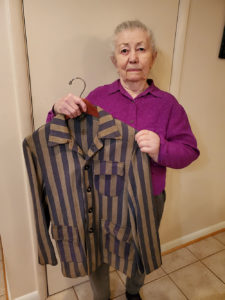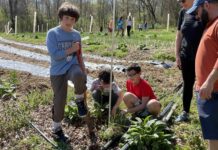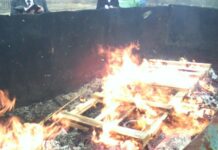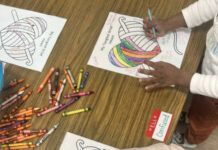
late mother, holds her husband Salomon’s jacket he brought when liberated from Mauthausen Concentration Camp. (Courtesy of Sara Moses Baum’s family)
The images are iconic. We’ve seen them in still photographs and black-and-white documentaries. Scores of children and emaciated men and women crowded behind barbed-wire fences. And almost always wearing the ubiquitous striped concentration camp uniform.
The Howard County Yom HaShoah Committee is gathering Holocaust artifacts, like that uniform, for its April 27 virtual Yom HaShoah Commemoration. The annual event, presented by the Howard County Board of Rabbis, began in the late 1970s. It honors victims of the Holocaust through a memorial candle lighting, readings, prayer, music, stories, artifacts, an essay competition and the annual Yizkor List. The committee has been collecting artifacts for about 12 years.
One such artifact is one of those striped uniforms, brought to the U.S. by Mauthausen Concentration Camp survivor Salomon Moses. His daughter, Sara Moses Baum, now works on the Yom HaShoah Committee, keeping his and others’ Holocaust stories and memories alive.
Salomon Moses, who slaved in the quarries at Mauthausen, was always in fear of dying or being murdered. Prisoners were not tattooed, so he feared dying in obscurity. He made his own identification tag in a camp shop, bearing his name, date of birth and birthplace (Krosno, Poland), prisoner number, camp and the date — 1944.
“Dad took a jacket out when he was liberated from the camp,” Sara Moses Baum said. “You can’t imagine people’s expressions when we display it [when the event is in person]. For them to feel it; what a course, heavy, rough material they wore in summer and winter.” Her mother survived slave labor camps in Siberia.
These and other artifacts, including passports, visas, letters, transport lists, postcards, photos and artwork, are just some of the kinds of items being collected by the Yom HaShoah Committee for the virtual event, to help tell the very personal stories of the Holocaust in visual and tactile ways.
Judy Gartner remembers being jealous of childhood friends who had doting grandparents. Her grandparents and other family members died in the Holocaust. Her grandmother was interned in Gurs detention camp in France; an aunt and uncle were sent to Theresienstadt (known as Terezin) transit/labor camp. She feels a broken connection in her family history.
She has a trove of documents, including letters between her mother and grandmother, passports, visa applications to get family out of Europe, a family tree and transit lists — some of which are part of the commemoration’s virtual archive.
“When my father wrote his memoirs the year before he died, it helped to give me this connection, or understanding too, of what he had been through and what his family life was like growing up, prior to coming to the United States,” she said. “It’s almost like a gift of memory as well.”
Madeleine Fagan’s father Andre Weiss survived Auschwitz, Buchenwald and Theresienstadt. He later collected stamps and other postal items in an album that includes propaganda paper money printed by the Nazis for camp prisoners, and postcards, letters and drawings sent from camp prisoners. One drawing by her father depicts life in Buchenwald. Images of this album are also part of the virtual archive.
“It shows him talking to fellow Buchenwald prisoner Wing Commander ‘Tommy’ Yeo-Thomas, a captured British spy who later was an inspiration for Ian Flemings’ James Bond,” she said. “The original drawing is housed in the Imperial War Museum in London.”
The committee continues its quest to collect and display Holocaust artifacts, “so that something like this doesn’t happen again,” Judy Gartner said. “So, we remember those people who lost their lives or who went through unbelievable things for the simple reason that they were Jewish.”
For Sara Moses Baum, the scope of what has been, and continues to be, collected from their “relatively small community,” is impressive.
“It’s incredible — the scope of just our little group. How the ephemera, which normally would have been discarded or worn out or combusted, has been treasured and looked after. For some, it’s all that remains of people and people’s lives at that time in history,” she said. “So, it takes on more than the object. It’s who it belonged to, how it was protected. And here it is now, for the next generation.”
To donate an item for display in the commemoration’s virtual archive, email [email protected]. To add a name to the Annual Yizkor List, email [email protected].






